Tabuk is home to a diverse range of bird species, many of which are migratory. It is a paradise for bird watchers, offering a wide variety of sights and sounds.
From the soaring eagles of Mount Al-Hada to the songbirds of Wadi Al-Qura, Tabuk offers a unique experience for bird lovers.
The region also has a wide variety of protected areas, including national parks, nature reserves, and wetlands, all of which provide a haven for birds and other wildlife. With its lush landscapes and diverse habitats, Tabuk provides an ideal environment for bird-watching.
1. Eurasian Collared Dove
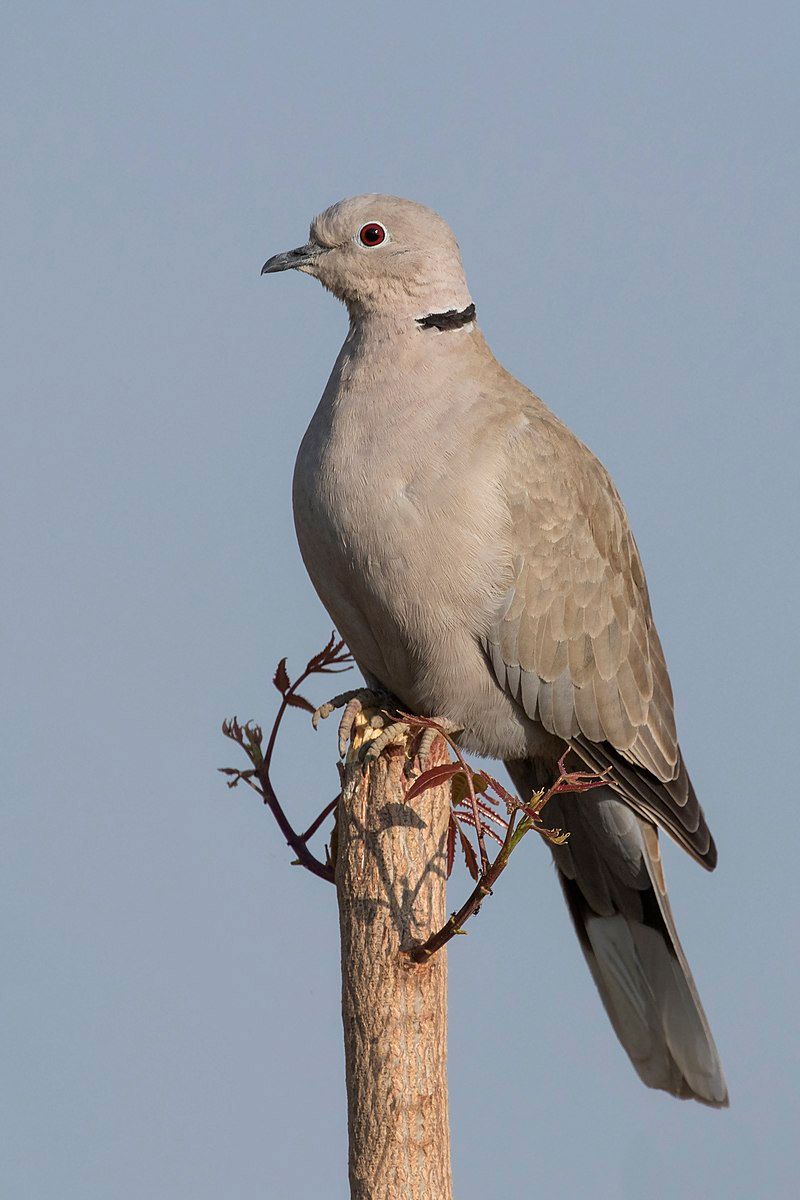
The Eurasian collared dove is a species of dove that is native to Europe and Asia. It is a medium-sized bird with an overall gray-brown coloration, and it is easily identifiable by the black band across the back of its neck.
The species was introduced to Japan, North America, and the Caribbean islands, where it has become established and widely distributed. Its introduction to these areas has been attributed to the escape of captive birds from aviaries, as well as intentional release by humans.
In Japan, the introduction of the Eurasian collared dove was so successful that it is now considered an invasive species, outcompeting native bird species for food and nesting sites.
In North America, the species is also having a negative impact on native bird species and is considered an agricultural pest.
Despite this, the Eurasian collared dove remains one of the most widely distributed bird species on the planet and is even considered a symbol of peace and unity in some cultures.
| Kingdom | Animalia |
| Phylum | Chordata |
| Class | Aves |
| Order | Columbiformes |
| Family | Columbidae |
| Genus | Streptopelia |
| Species | S. decaocto |
2. Namaqua Dove
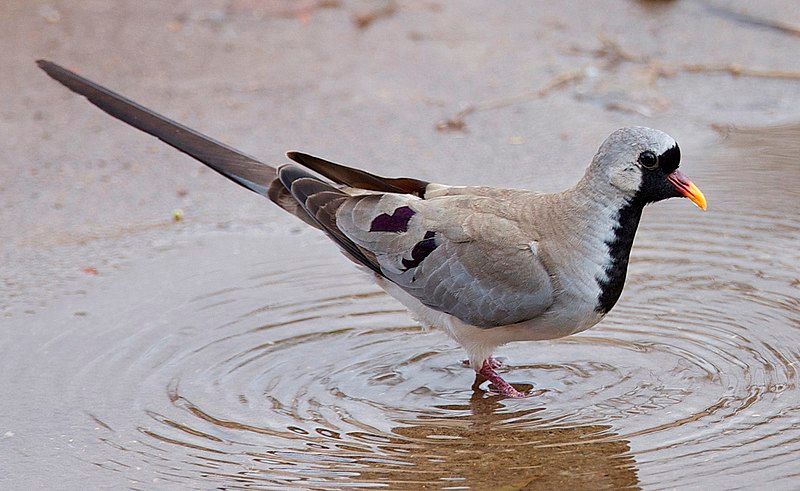
The Namaqua dove is a small, attractive bird belonging to the pigeon family. It is the only species in the genus Oena and is native to a wide area that includes much of Sub-Saharan Africa, Arabia, and Madagascar.
The bird has a distinctive grey-brown plumage and a distinctive white collar that runs around its neck. Its diet consists mainly of seeds, and it is an opportunistic feeder, which means it will take advantage of any available food sources.
Its call is a characteristic “coo” sound. The Namaqua dove is a social bird, and can often be seen in small flocks, as they enjoy the companionship of their own kind.
They are also quite resilient and can survive in a wide variety of habitats, from open grasslands to arid deserts. During the breeding season, the male will perform a courtship dance to attract a female.
Once a partner has been found, the pair will build a nest together, and the female will lay two white eggs. The Namaqua dove has adapted well to human-altered landscapes, and can often be found in urban areas.
They are a peaceful and beneficial species and are an important part of the local ecosystem. They help to disperse seeds, and in turn, help to regenerate vegetation in their environment. For this reason, they are a protected species in many parts of their range.
| Kingdom | Animalia |
| Phylum | Chordata |
| Class | Aves |
| Order | Columbiformes |
| Family | Columbidae |
| Genus | Oena |
| Species | O. capensis |
3. Laughing Dove
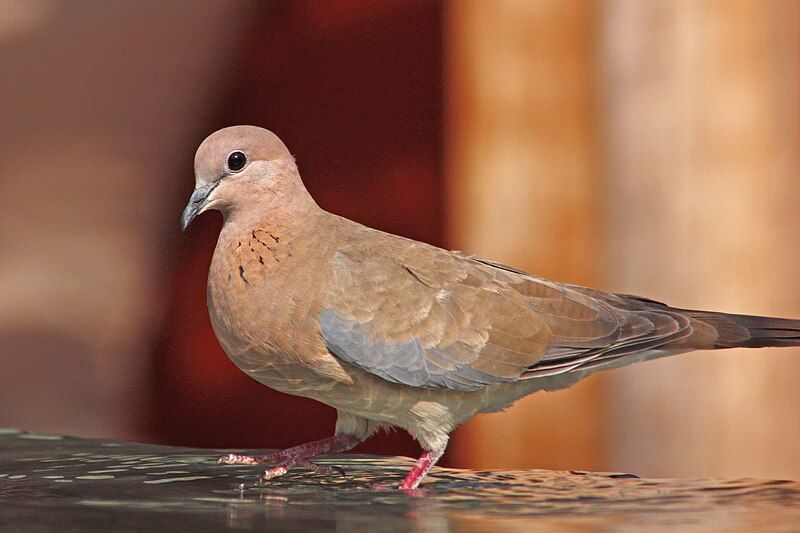
The Laughing Dove is a species of small pigeon that is found throughout a large area of the world. It is a resident breeder in Africa, the Middle East, South Asia, and Western Australia.
This species of pigeon is particularly notable in Western Australia, where it has become a part of the local wildlife after being released from Perth Zoo in 1898. The Laughing Dove is a small pigeon, usually measuring between 25 and 30 centimeters in length.
It is easily distinguishable from other pigeon species by its distinct call, which is described as sounding like soft laughter.
The Laughing Dove has a wide range of habitat preferences, and can often be seen in agricultural areas, open woodlands, and even around cities and towns. This species of pigeon feeds mainly on seeds, grains, and insects, and is often seen in small flocks in open areas.
| Kingdom | Animalia |
| Phylum | Chordata |
| Class | Aves |
| Order | Columbiformes |
| Family | Columbidae |
| Genus | Spilopelia |
| Species | S. senegalensis |
4. Black-winged Stilt
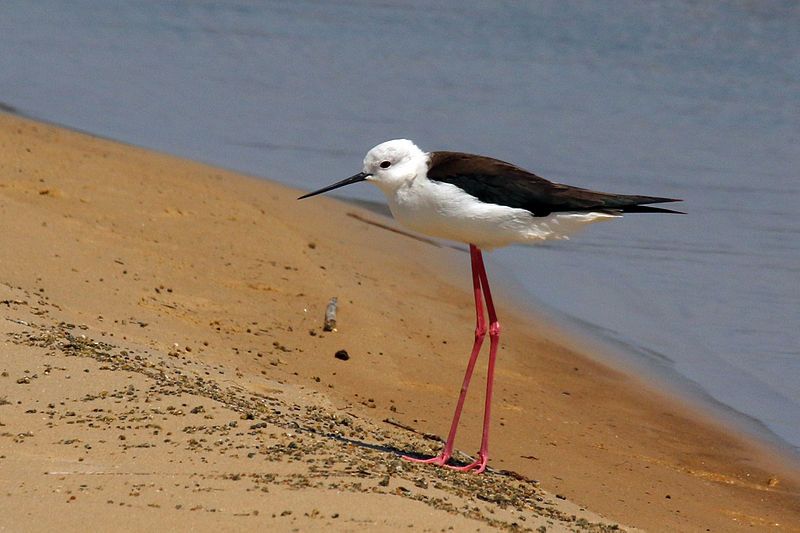
The black-winged stilt is a species of wading bird belonging to the avocet and stilt family, and it can be found all over the world. It is characterized by its exceptionally long legs, which give it an even more impressive presence in its watery habitat.
The scientific name for this species is H. himantopus, and it is the only species currently recognized in this family. These birds are usually seen in shallow wetlands, such as estuaries and lagoons.
They feed mainly on aquatic invertebrates, such as shrimp, insects, and small fish.
The black-winged stilt is also known to eat some plant matter, such as seeds and aquatic plants. Their breeding season begins in the spring, when they build their nests in shallow water, usually on flat ground.
They typically lay two or three eggs, which are incubated by both parents. Both parents also take turns protecting the nest from predators. The black-winged stilt is an important part of the ecosystem, as it helps to control the populations of its prey, which are often pests.
It is also an important source of food for other species of birds, mammals, and even humans. Unfortunately, its population is declining in many parts of the world due to habitat destruction and other human activities.
Conservation efforts are needed to ensure that this species will continue to be a part of our planet’s biodiversity.
| Kingdom | Animalia |
| Phylum | Chordata |
| Class | Aves |
| Order | Charadriiformes |
| Family | Recurvirostridae |
| Genus | Himantopus |
| Species | H. himantopus |
5. Common Quail
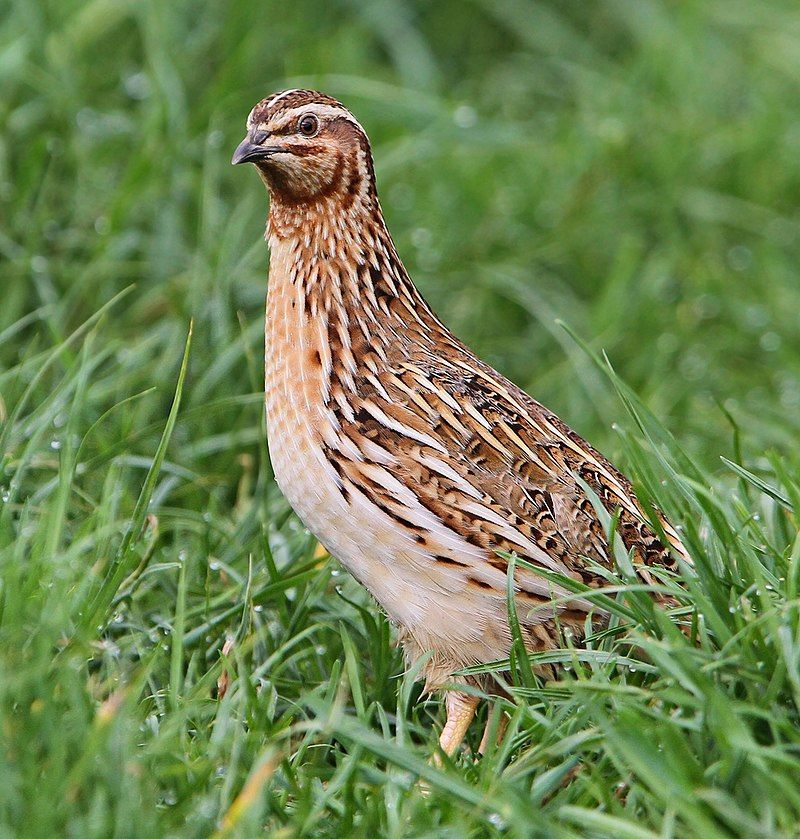
The common quail, also known as the European quail, is a small bird in the pheasant family Phasianidae. It is known as a ground-nesting game bird, meaning that it builds its nests on the ground rather than in trees or other elevated areas.
The common quail is a migratory species, meaning that it breeds in the western Palearctic region and winters in Africa and southern India. The most characteristic feature of the common quail is its call.
It is typically a series of three short, repeated chirps, which is how it is most often heard. The common quail is not particularly visible due to its small size, so its call is the most common way for humans to detect it.
In conclusion, the common quail, or European quail, is a small game bird in the pheasant family Phasianidae. It is migratory, breeding in the western Palearctic and wintering in Africa and southern India.
Its call of three chirps is the most characteristic feature of the species and a great way for humans to detect its presence.
| Kingdom | Animalia |
| Phylum | Chordata |
| Class | Aves |
| Order | Galliformes |
| Family | Phasianidae |
| Genus | Coturnix |
| Species | C. coturnix |
6. Brown Booby
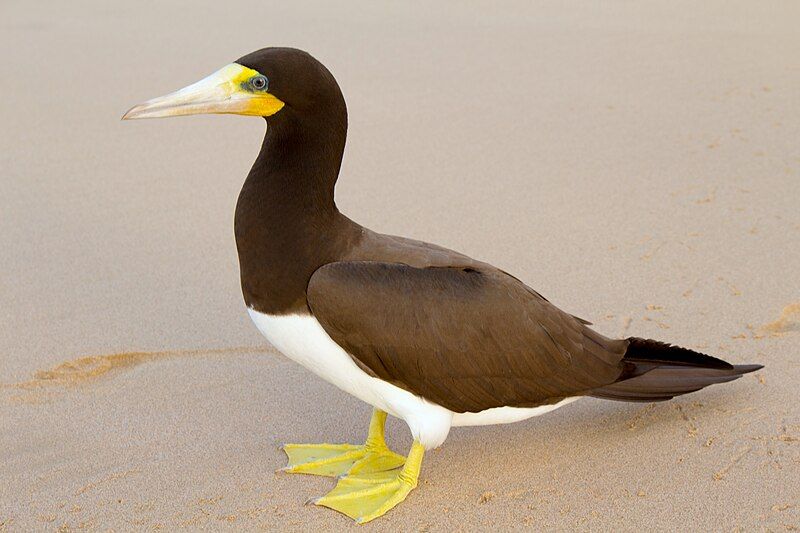
The brown booby is a type of seabird from the Sulidae family, which is the most commonly seen and spread species in this group. This species has a pantropical range, which means it is found in many parts of the world, and it often overlaps with other species of boobies.
Unlike other species of birds, the brown booby likes to live in groups and frequently flies close to the shore while searching for food. This behavior is known as commuting and foraging..
| Kingdom | Animalia |
| Phylum | Chordata |
| Class | Aves |
| Order | Suliformes |
| Family | Sulidae |
| Genus | Sula |
| Species | S. leucogaster |
7. Greater Flamingo
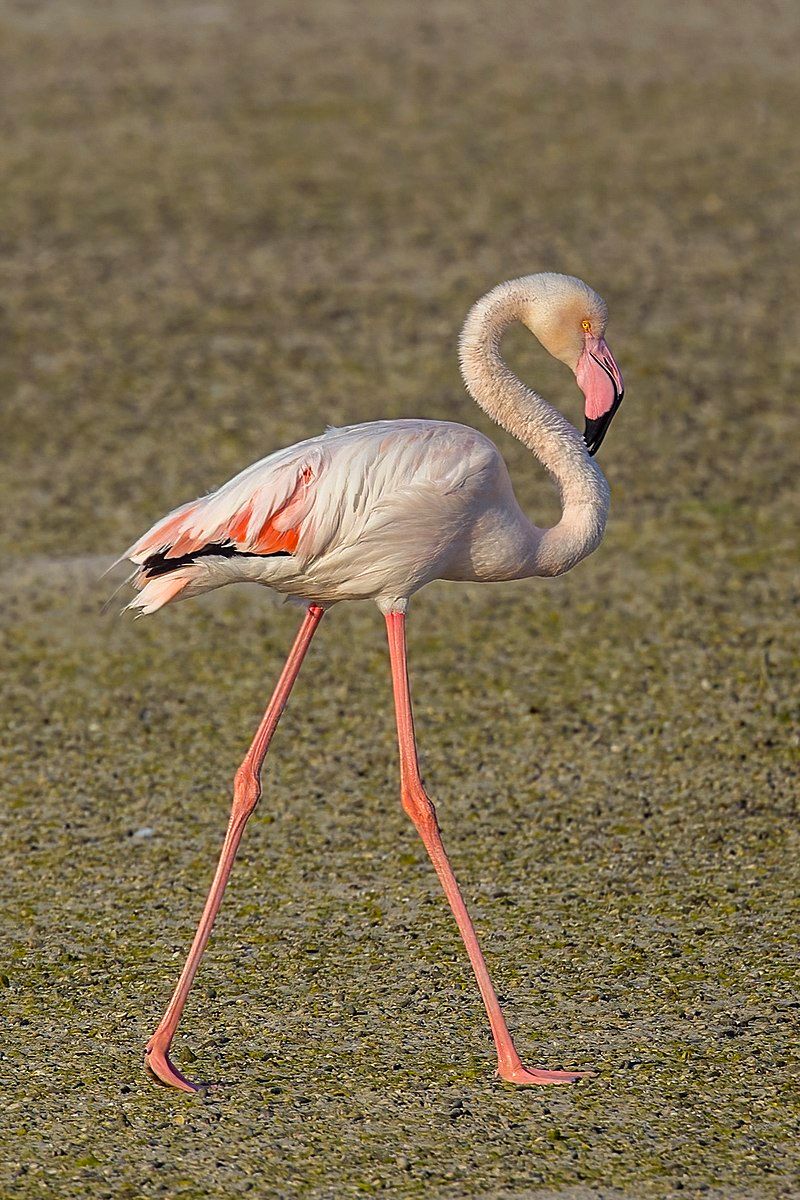
The greater flamingo is the largest and most widespread species of flamingo found in the world. These birds can be found in many regions, from Northern Africa to the Middle East, and from the Indian Subcontinent to the Mediterranean countries of Southern Europe.
They are commonly seen in wetlands, lagoons, and lakes, and they are even found in areas of the Gulf of Aden, the Red Sea, and the Persian Gulf. The greater flamingo is a colorful species with a long neck, a pinkish-white body, and a bright red bill.
They stand up to five feet tall with long legs that allow them to wade in shallow water to forage for food. The greater flamingo is a social species and often congregates in large flocks, making them a striking sight in the wild.
| Kingdom | Animalia |
| Phylum | Chordata |
| Class | Aves |
| Order | Phoenicopteriformes |
| Family | Phoenicopteridae |
| Genus | Phoenicopterus |
| Species | P. roseus |
8. Crab-plover
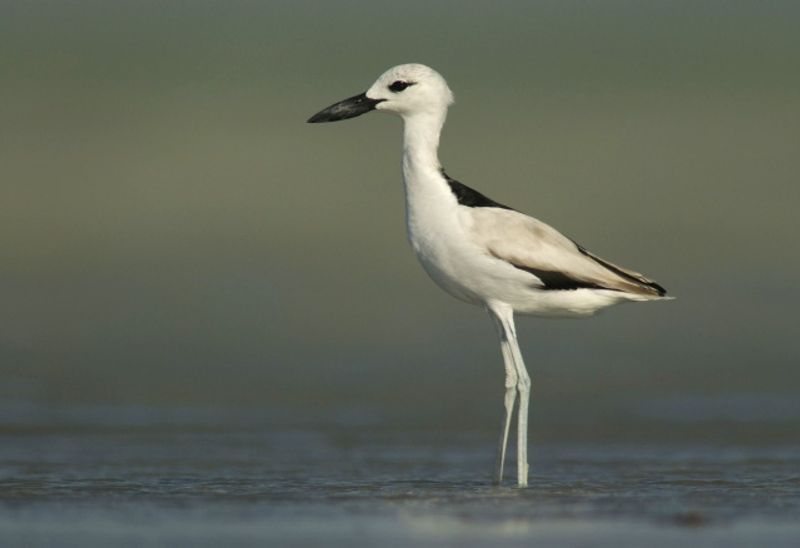
The crab-plover is a unique species of bird belonging to the group known as waders. It is so distinctive from the other species that it has its own family, the Dromadidae. This species of bird is found primarily around coastal regions, estuaries, and mudflats.
It feeds mainly on small crustaceans, such as crabs, as well as various types of worms and mollusks. The crab-plover is a fairly large wader, with a length of up to 25 cm and a wingspan of up to 45 cm.
It is a highly migratory species, with a yearly breeding range that includes the Indian Ocean, Arabian Sea, Persian Gulf, and parts of the Pacific Ocean. It is also known to be a noisy bird, with a loud, melodious call.
In addition, it has a distinctive, unique plumage, with a white head and chest, black back, and white underparts. The crab-plover is a solitary bird, often seen alone or in pairs. It is also a long-distance flier, capable of traveling vast distances in search of food.
Despite being a species of conservation concern, the crab-plover is a fascinating bird to observe and appreciate.
| Kingdom | Animalia |
| Phylum | Chordata |
| Class | Aves |
| Order | Charadriiformes |
| Family | Dromadidae |
| Genus | Dromas |
| Species | D. ardeola |
9. Great Cormorant
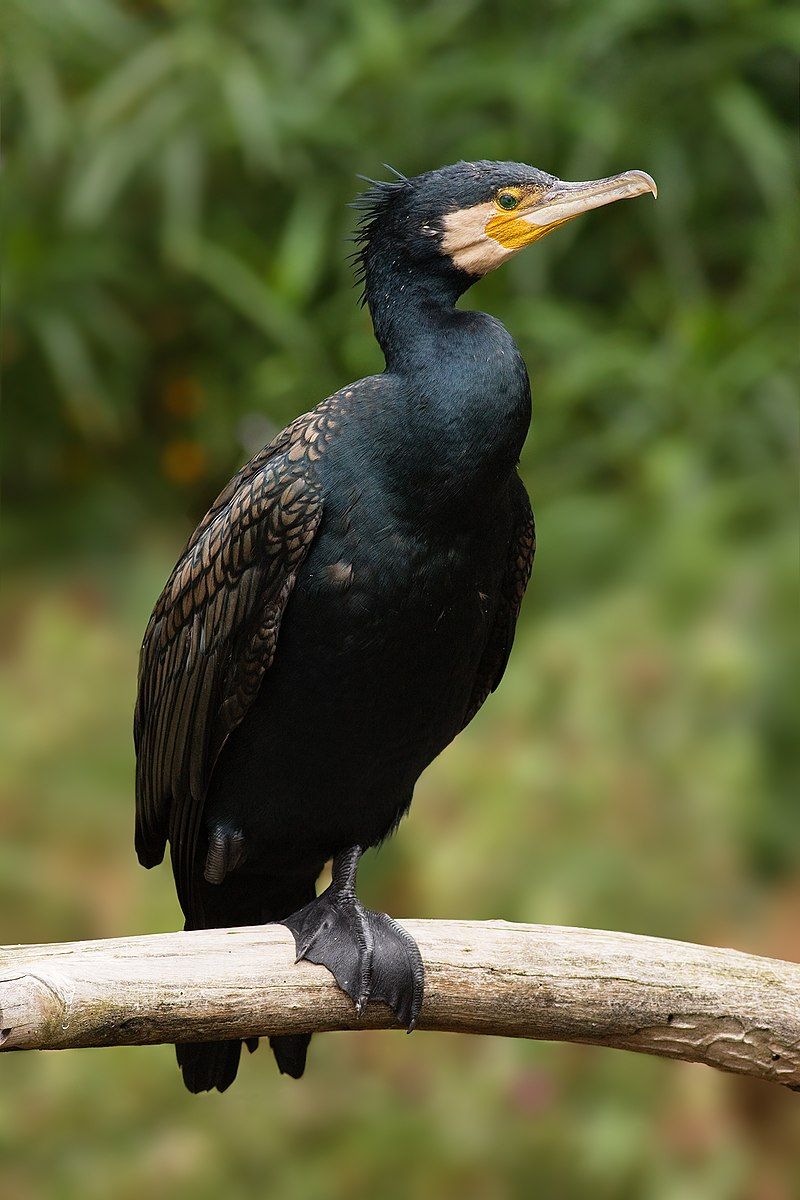
The great cormorant is a seabird species found across the Northern Hemisphere, Australia, New Zealand, and India.
It is known by various names in each region, such as the black shag or kawau in New Zealand, the great black cormorant across the Northern Hemisphere, the black cormorant in Australia, and the large cormorant in India.
It is a member of the cormorant family, which is known for its diving and swimming abilities. The great cormorant is a large bird, with a wingspan of up to 4 feet and a body length of up to 2.5 feet. It has a blackish-green plumage, with a yellowish-orange throat patch.
The great cormorant is a marine bird that inhabits coastal areas, estuaries, harbors, and open seas. It is a powerful swimmer and diver and can stay underwater for up to one minute.
It is an active hunter and feeds mainly on fish, but also eats crustaceans, amphibians, and invertebrates. The great cormorant often nests in colonies, either on the ground or in trees. It builds nests out of sticks and seaweed.
The great cormorant is a species of least concern according to the International Union for Conservation of Nature (IUCN). It has a wide distribution and is not threatened by human activities or by declines in its prey population.
Its population is stable and the species is not believed to be in decline.
| Kingdom | Animalia |
| Phylum | Chordata |
| Class | Aves |
| Order | Suliformes |
| Family | Phalacrocoracidae |
| Genus | Phalacrocorax |
| Species | P. carbo |
10. Glossy Ibis
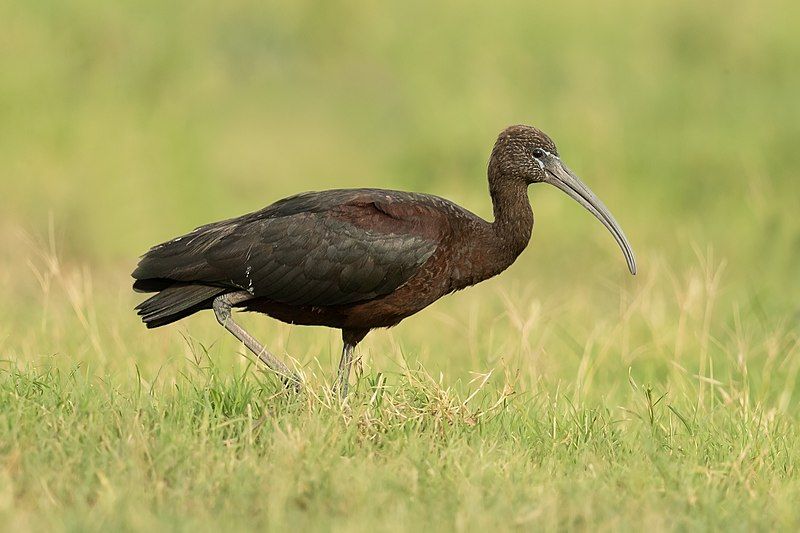
The glossy ibis is a species of water bird belonging to the order Pelecaniformes and the ibis and spoonbill family Threskiornithidae. This species of bird is characterized by its long, curved beak, which is what gives it its scientific name.
The scientific name of the glossy ibis is derived from the Ancient Greek words pleads and Latin falcis, both of which translate to ‘sickle’ in English. This is in reference to the distinctive shape of the glossy ibis’s bill, which is curved in the shape of a sickle.
The glossy ibis is a relatively small species of bird, typically measuring between 40 and 50 centimeters in length. It has a wingspan of between 80 and 100 centimeters, and its body is covered in a glossy black or dark brown plumage.
The glossy ibis’s beak is a bright yellow-orange color, and its legs and feet are a darker shade of yellow. The glossy ibis is typically found in wetlands, lakes, and marshes. It feeds on a variety of aquatic creatures, including insects, fish, and crustaceans.
| Kingdom | Animalia |
| Phylum | Chordata |
| Class | Aves |
| Order | Pelecaniformes |
| Family | Threskiornithidae |
| Genus | Plegadis |
| Species | P. falcinellus |
11. Whimbrel
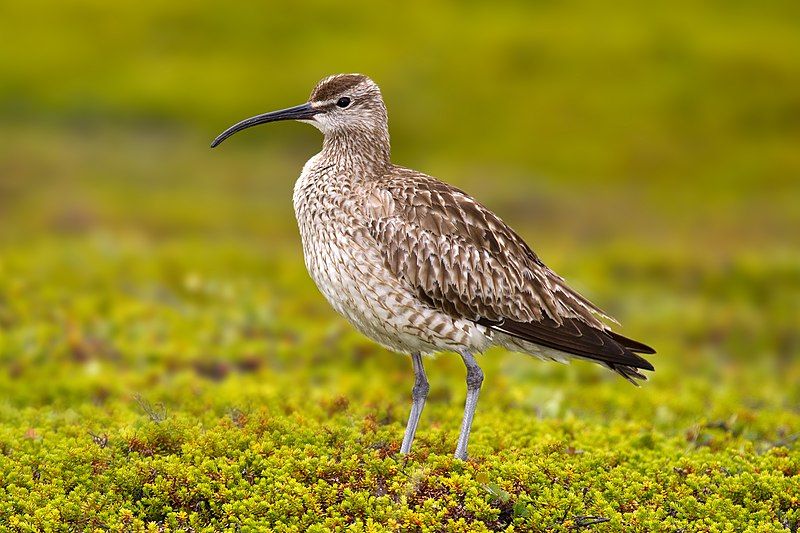
The Eurasian or common whimbrel is a type of water that belongs to the Scolopacidae family. A wader is a type of long-legged shorebird that frequents coastal environments. The common whimbrel is also known as the white-rumped whimbrel in North America.
This species of bird is one of the most widespread of the curlews, which is a group of waders. The common whimbrel breeds across much of subarctic Asia and Europe, and it is even found as far south as Scotland.
They are most commonly found in coastal environments and they feed on small aquatic animals, such as molluscs, crustaceans, and insects. The common whimbrel is a migratory bird and during winter, it can be found in Africa, India, and south-east Asia.
The species is listed as Least Concern by the IUCN, indicating that it is not threatened with extinction.
| Kingdom | Animalia |
| Phylum | Chordata |
| Class | Aves |
| Order | Charadriiformes |
| Family | Scolopacidae |
| Genus | Numenius |
| Species | N. phaeopus |
12. Black-tailed Godwit
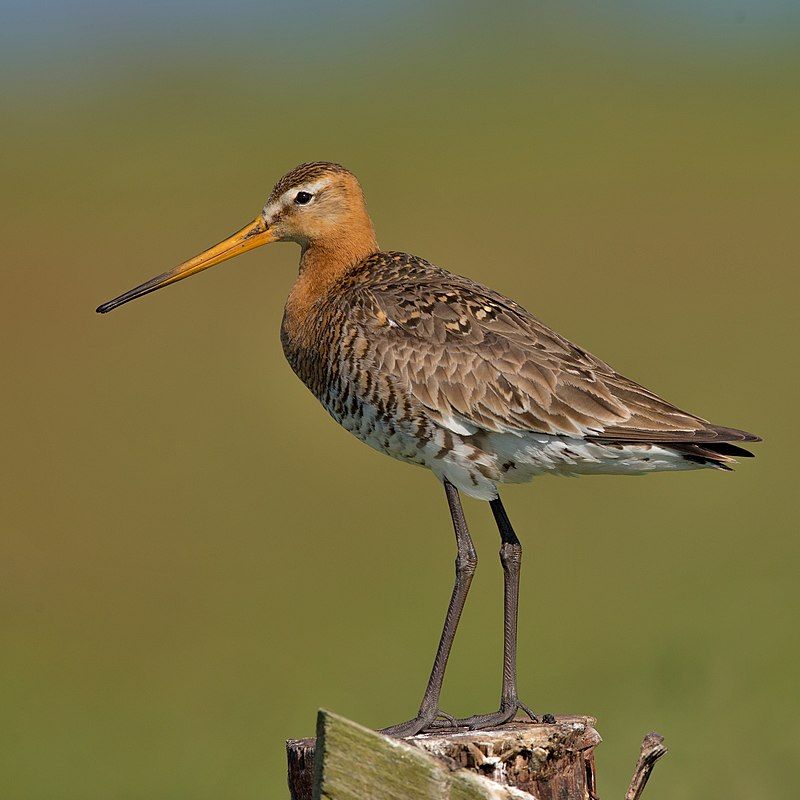
The black-tailed godwit is a species of shorebird that was first described by the famous Swedish botanist and zoologist, Carl Linnaeus, in 1758. It is usually identified by its large size, long legs, and long bill.
It belongs to the genus Limosa, which also includes other species of godwit such as the bar-tailed godwit and the Hudsonian godwit. The black-tailed godwit is a migratory species that breeds in the northern European region and northern Asia.
It migrates south to spend the winter in Africa, India, and Southeast Asia. It is an omnivorous bird, consuming a variety of food such as insects, fish, snails, worms, and other small invertebrates. It is also known to feed on seeds, grains, and fruits.
The black-tailed godwit has several distinctive features that help it to be identified from other shorebirds. Its most notable feature is its long, straight bill which is used to probe in mud for food. Its wings are also long and slender, and its legs are a reddish-brown color.
Its body is mottled black and white, with white markings on its neck and chest. The black-tailed godwit is an important species for conservation, as it is listed as Near Threatened on the IUCN Red List.
As its preferred habitat of mudflats is increasingly threatened by human activities, its population is declining. Therefore, conservation efforts are needed to ensure that this species does not become endangered.
| Kingdom | Animalia |
| Phylum | Chordata |
| Class | Aves |
| Order | Charadriiformes |
| Family | Scolopacidae |
| Genus | Limosa |
| Species | L. limosa |
13. Broad-billed Sandpiper
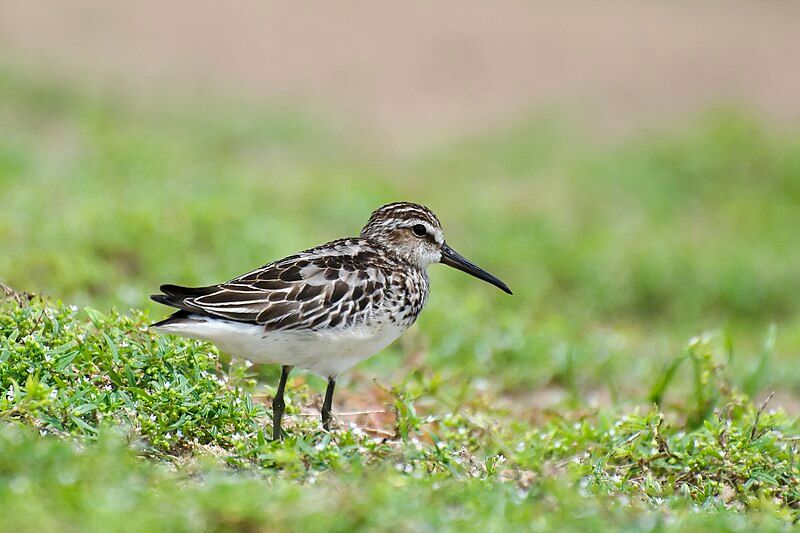
The broad-billed sandpiper is a small wading bird found in many parts of the world. It is known scientifically as Limicola falcinella, with its specific name, falcinella, deriving from the Latin word falx, falcis meaning “a sickle”.
Recent research has suggested that the broad-billed sandpiper may have more in common with species of the genus Philomachus, a group of birds that includes the ruff, than with other species classed in the genus Limicola.
This would suggest that the broad-billed sandpiper should be reclassified in the genus Philomachus. This is still an area of debate amongst ornithologists, with further research needed to determine the species’ true classification.
| Kingdom | Animalia |
| Phylum | Chordata |
| Class | Aves |
| Order | Charadriiformes |
| Family | Scolopacidae |
| Genus | Calidris |
| Species | C. falcinellus |
14. Pin-tailed Sandgrouse
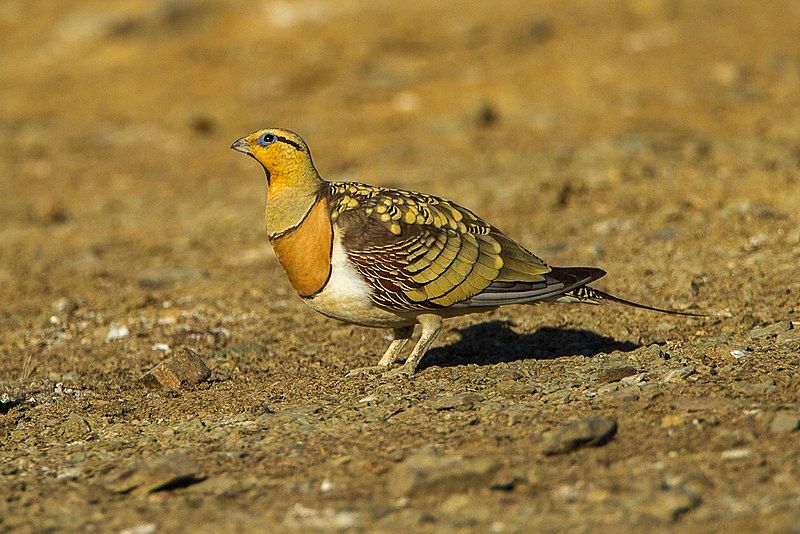
The pin-tailed sandgrouse is an attractive bird belonging to the sandgrouse family. It is a medium-sized bird with a small, pigeon-like head and neck, and a sturdy, compact body. Its wings are long and pointed, with white undersides, and its tail is also long.
Its flight is fast and direct, and it often flies in flocks, heading to watering holes before sunrise. Its call is a loud, distinctive “kattar-kattar”. This species is well known to birdwatchers for its beauty and its unique call.
| Kingdom | Animalia |
| Phylum | Chordata |
| Class | Aves |
| Order | Pterocliformes |
| Family | Pteroclidae |
| Genus | Pterocles |
| Species | P. alchata |
Conclusion
Birds in Tabuk are an important part of the ecosystem, providing food, shelter, and entertainment to both people and wildlife. They are a valuable asset to the region, and their conservation and protection should be a priority.
Conservation and protection efforts should focus on preserving and protecting the habitats of the birds, as well as ensuring that they have the right resources and food sources in order to survive.
The government and local communities should also work together to ensure that birds in Tabuk are protected and respected.